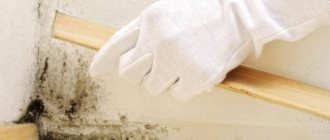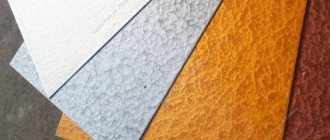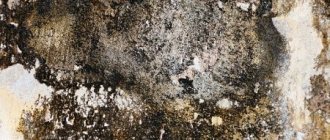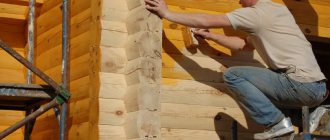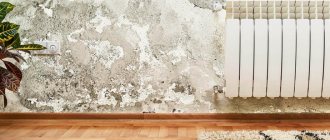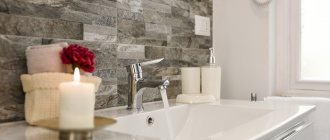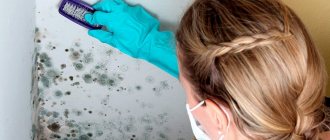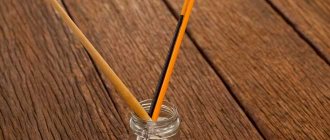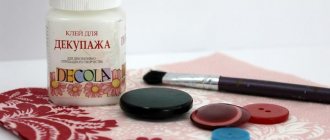If the coatings are moisture-resistant and can be painted, then anti-mold paint will be the best solution. It is applied to gypsum, plastered, concrete, putty, and brick walls. It is also allowed to paint plasterboard sheets and fiberglass wallpaper.
Fungus-resistant coatings are produced by the following companies:
- Capital;
- Pufas;
- Auro;
- Glutoclean;
- Dufa;
These manufacturers produce products with the addition of antibacterial substances for exterior and interior painting work. Paint for work on the outside of the house must have a good water-repellent effect, since it will often be exposed to rain, fog, and snowfall. And for interior work, it should be odorless and dry quickly.
Mold and mildew on the wall
Mold and mildew on the walls appear in the form of dark spots and efflorescence. They look ugly, but what’s worse is that they are harmful to health. Painting over the stains will do nothing, and, in addition, fungi and smudges will appear again. The fight against mold and fungi must begin with eliminating the cause of its occurrence. The main reason is excess moisture, which, in turn, occurs due to insufficient ventilation, flooding of the apartment (from neighbors or a leaking roof), improper insulation of the building, freezing of the wall or ceiling. It is by eliminating these primary causes that you need to begin the fight against fungi and mold.
It's not easy, but it's really necessary to effectively get rid of mold and mildew on your walls and ceilings.
How to use anti-mold paint
Before applying the product, the main thing is to properly prepare the surface. The durability of the repair and the reliability of protection against fungus depend on this.
Before using paint for walls and ceilings, you must:
- Remove the separating layer from the surface: chalk, old coating, lime.
- If the base absorbs moisture or is loose, it is better to first coat it with an acrylic primer.
- The prepared wall must be dry, clean and solid.
“Supersil” paint, presented in the SKS-CRIMEA online store, is applied using a spray gun, brush or roller. The first layer can be diluted with a little water. The final coat must contain only a colorant.
During operation, temperature is also of great importance. Walls are painted at 15-25 degrees. There should be a gap between applying the next layer. It is better if it is several hours. It will take a month to dry completely. During this time, it is undesirable to wipe the walls, as well as to exert mechanical influence on them.
If you follow all the recommendations and rules, “Supersil” will help get rid of mold in a room with high humidity. If necessary, you can additionally use the primer antiseptic “Profiwood”.
How to paint a wall affected by mold and mildew
After eliminating the cause of mold and mildew, we can begin to give our walls the appropriate appearance. You need to be aware that the fungus can be present not only on the surface of the wall, but also located deeper - this situation arises if the base is wet for a long time. What and how to paint walls affected by fungus?
The correct method is selected depending on how deeply the fungus has penetrated. If the fungal infection is superficial, then you can cope with it yourself, using specialized preparations specially designed for this - fungicides.
To combat fungi and mold, specialized preparations are used (for example, Alpa Fongifluid). The drug penetrates deep into the base into all the corners and pores of the wall, thanks to which it fights not only with lesions on the surface, but also in the depths of the wall. It can be applied to various surfaces (except wood). The antifungal agent is applied to the wall with a brush or roller. For more detailed usage, please refer to the manufacturer's instructions.
If the fungus has penetrated deep into the wall, the plaster will need to be removed (not only at the site of infection, but also within a meter radius of it). Then the surface must be protected with several layers of a fungicidal preparation, and only then the wall must be plastered.
Why is it dangerous to health?
If fungus is detected, it must be removed immediately. Otherwise, small spots will continue to grow, forming huge pockets of mold.
The lack of measures to eliminate fungus can be fraught with serious consequences for the health of household members. The waste products of the fungus enter the human body through the respiratory system.
Possible consequences:
- joint diseases;
- allergic reactions;
- headache;
- dermatoses;
- asthma;
- nausea;
- runny nose, cough;
- candidiasis.
Important! In addition to the fact that mold spoils the aesthetic appearance of the bathroom, it destroys finishing and building materials. When it lands on a particular surface, it grows into it in small threads and gradually destroys its structure.
How to paint a wall with splashes and smudges
It happens that smudges and rusty yellow spots appear on the walls (for example, after flooding). Unfortunately, painting over yellow stains with regular paint, especially light paint, is not always effective - despite applying several layers of paint, rusty stains will come to the surface. One solution is to use dark colors, which cover up stains more effectively. However, this is a rather serious limitation in the choice of color. If we want to paint yellow stains on the walls or ceiling in any color, we need to take a special paint for stains and stains (for example, Snezhka). The paint can be used as a primer or as a basic finishing coat, which will effectively “cut off” difficult stains (the paint is available in white, but it can be diluted with color without any problems).
Varieties
Mold in the bathroom can be divided into several types:
- black mold . Most often found in the bathroom, especially at the joints of tiles. The danger of black mold is that it negatively affects the respiratory system, reduces the body's protective functions and puts the immune system at risk;
- white mold . In the bathroom it is much less common than black. Most often it lives on the walls of rooms;
- green mold (Trichoderma) . It often affects building materials, contributing to their destruction.
Kitchen and Bathroom Paints
Kitchens and bathrooms, rooms where there is high humidity, high temperature and various pollution. Therefore, to decorate the walls in the kitchen and bathroom, it is worth choosing a specialized biocidal paint designed specifically for these rooms. A good option are paints containing pure silver, which works as an antiseptic throughout the life of the paintwork. Other important features that kitchen and bathroom paint should have are increased moisture resistance and resistance to abrasion and washing.
← Previous material
Next material →
Reasons for appearance
Mold spores are present in any room. When conditions are favorable, the fungus begins to multiply. It is not surprising that most often mold appears in the bathroom, where the air temperature does not drop below 15-20 degrees, and regular use of water maintains the humidity level.
Thus, the main causes of mold include:
- high air humidity;
- high room temperature;
- poor waterproofing;
- insufficient ventilation.
In terms of surfaces, mold is not picky: it can grow on plastic, wood and even silicone sealant. When contacted with a damp surface, the spores begin to germinate and form small colonies. Most often this happens when air humidity rises to 90%, while humidity of 70-80% is considered the norm.
Prevention measures
The best prevention of fungus is to maintain cleanliness and prevent dampness. Ventilation valves must be installed on double-glazed windows, and ventilation must be installed in bathrooms and kitchens. It is important to insulate freezing walls, and in a private house to build a strong foundation and blind area. You need to check the plumbing: there are no leaks or breakdowns, otherwise fungus will inevitably settle in the bathroom.
If the air is too humid, uniform heating and installing an air conditioner to dry the air help. Reduces the risk of mold by drying clothes on the balcony rather than in the apartment, regularly using a kitchen hood, and frequently washing areas where mold may appear with antiseptic agents.
Danger of mold
When we breathe, mold spores enter our lungs, from there they are absorbed into the blood and spread to all organs and tissues. Also, fungal spores land on the surface of the skin and penetrate through it into the body. Constant contact with these colonies leads to health problems such as:
- migraine;
- allergic reactions, especially in childhood;
- bronchial asthma – also often develops in children;
- sinusitis;
- mycosis is a fungal disease that affects all human organs;
- pathologies of the gastrointestinal tract;
- pathologies of the liver, kidneys;
- diseases of the musculoskeletal system;
- Also, fungal toxins can cause poisoning, manifested by nausea and vomiting.
Also, pregnant women should pay special attention to mold in the house. Pregnancy and indoor fungus are incompatible. A woman’s body during the period of bearing a child is much more susceptible to poisoning, moreover, in such a situation the fetus may suffer.
Where to look for fungus?
Even if visually you cannot immediately detect traces of the presence of mold, you should look for it in places hidden from view.
It can be:
- corners of walls in contact with the bathroom;
- gaps between tiles;
- places where plumbing fixtures connect to the walls;
- under the baseboards in the area of the sink and bathtub;
- on the ceiling;
- under the rug on the floor;
- in wood paneling;
- in cups for hygiene items.
Having penetrated into other rooms, the spores, if they do not germinate, retain their ability to reproduce for a long time and are just waiting for favorable conditions.
It is impossible to completely get rid of them, but creating unsuitable conditions for their development is quite possible.
Safety precautions when working
When processing the premises, it is worth using personal protective equipment - rubber gloves, cotton-gauze bandages or pharmaceutical masks, respirators. It is better to wear glasses on your eyes when using caustic solutions. It is recommended to carry out all work wearing thick protective clothing.
After finishing the treatment of the walls, you need to thoroughly ventilate the room, wash the clothes, and throw away the rags and sponges, packing them in a bag. If allergies, nausea, or vomiting occur, you should consult a doctor - this may be a sign of intoxication.
Coloring rules
To obtain a high-quality and durable result, it is important not only what to paint the cellar with, but also how exactly to do it. No matter how modern the paint is, it will not help provide reliable coverage if the technology is violated. The procedure must be performed as follows:
- The room is cleared of all unnecessary things, racks and shelves for products are removed. All items that will be stored in storage must be carefully treated with a protective compound.
- Craftsmen recommend drying the cellar before painting. This is done using different methods, but their essence is the same – to remove as much moisture as possible from the room.
- The bases are cleaned of dirt, stains and dust are removed.
- Damaged walls are filled with cement mortar, then it must dry. The surfaces are leveled using a special grater.
- The last step is to apply a primer. It must penetrate deeply into the structure of the material, contain antiseptics and protection from moisture.
Preparing walls for painting Source recn.ru
When arranging a cellar, you must definitely think about the ventilation system. Access to fresh air will extend the life of any coating.
